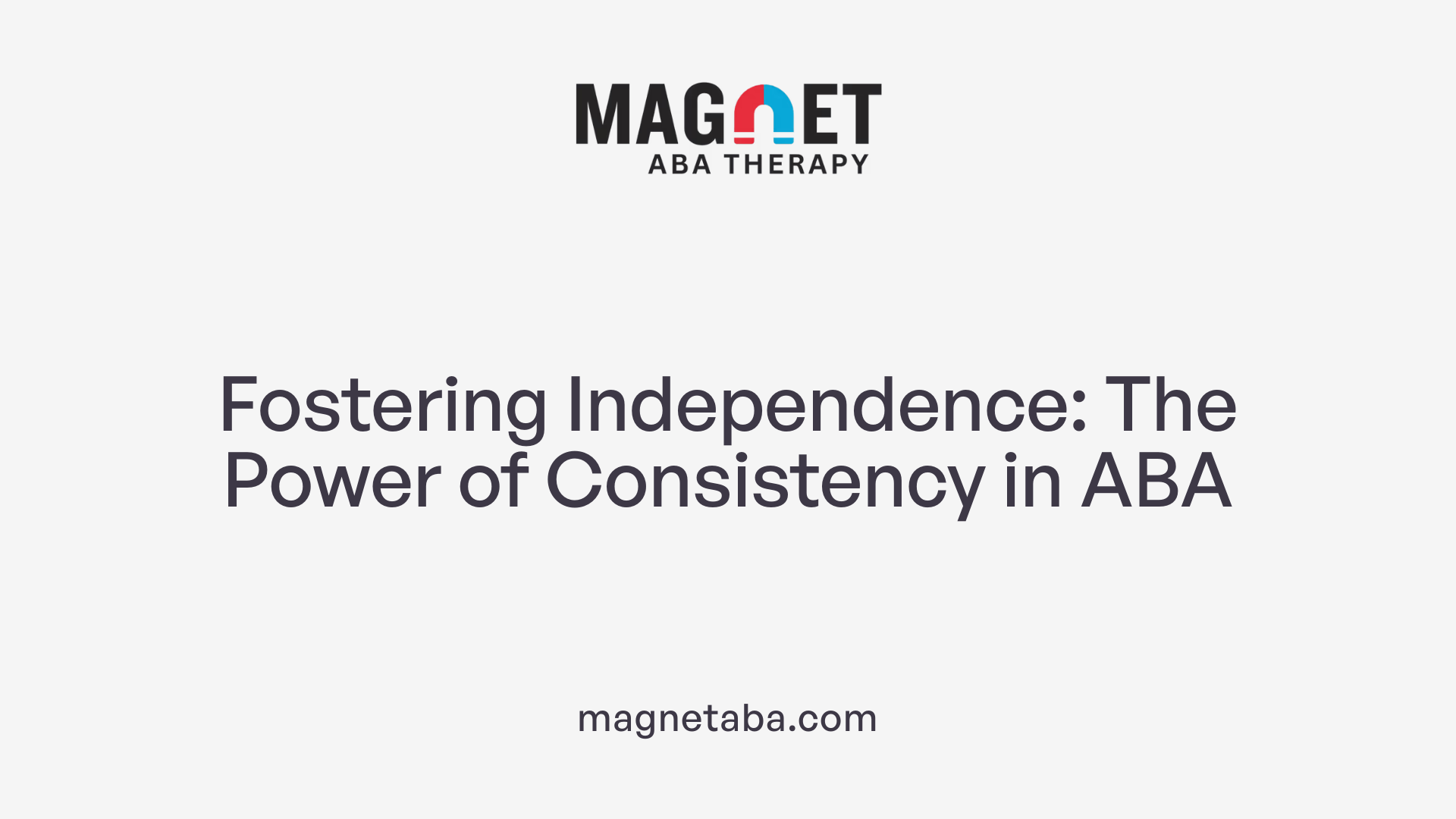Understanding the Foundations of ABA Therapy
Applied Behavior Analysis (ABA) therapy is widely recognized as an effective, evidence-based approach for supporting children with Autism Spectrum Disorder (ASD). Central to the success of ABA therapy is the consistent application of strategies across all environments and caregivers. This article explores how therapist consistency plays a vital role in ABA outcomes, affecting skill generalization, behavior reinforcement, and overall progress in children with ASD.
What is Applied Behavior Analysis (ABA) Therapy?
Understanding ABA Therapy
Applied Behavior Analysis (ABA) therapy is a scientifically grounded approach designed to improve behaviors by examining the environmental factors that influence them. It focuses on increasing positive behaviors such as communication, social engagement, and learning, while reducing behaviors that may be harmful or disruptive.
Scientific Basis and Goals
ABA relies on principles like reinforcement, prompting, and extinction to shape behavior. By carefully analyzing the antecedents and consequences of actions—commonly called the 'A-B-Cs'—ABA teaches new skills and helps children function better in their daily lives.
Role of Reinforcement and Prompting
Positive reinforcement encourages repetition of desired behaviors, while prompting guides children through steps until they can perform tasks independently. These strategies help children with autism acquire important social and adaptive skills.
Individualized Treatment Plans
Each ABA program is tailored to the child’s unique needs, developed by a Board-Certified Behavior Analyst (BCBA). These plans outline specific goals and strategies based on thorough assessments.
Duration and Oversight
Therapy typically spans one to three years, involving structured sessions that may occur multiple times per week. Ongoing supervision by certified professionals ensures that interventions remain effective and are adjusted as needed.
ABA is widely endorsed as one of the most effective interventions for autism spectrum disorder, supporting children in developing crucial social, communication, and life skills that enhance their independence and quality of life.
How ABA Therapy Supports Children on the Autism Spectrum
How does ABA therapy help individuals on the autism spectrum?
ABA (Applied Behavior Analysis) therapy is designed to understand and improve behaviors in children with autism using the ABC model—Antecedent, Behavior, and Consequence. By analyzing what triggers behaviors and the results that follow, ABA helps to increase positive behaviors like communication, social skills, attention, and daily living abilities.
What target behaviors does ABA therapy address?
ABA targets a wide range of behaviors, including emotional regulation, social interaction, communication skills, adaptive behaviors, and practical daily activities. These behaviors are crucial for helping children become more independent and perform effectively in everyday situations.
How is ABA therapy customized to a child’s needs?
Each ABA program is highly individualized, meaning that therapists develop tailored treatment plans based on the specific strengths and challenges of the child. This customization makes therapy more effective and meaningful for the child’s development.
In which settings is ABA therapy implemented?
ABA is used across multiple environments such as home, school, and community settings. Consistency across these settings ensures that children can generalize skills—for example, using the same visual cues to request a break in therapy, at home, and in school helps solidify learning.
What are the benefits of early intervention using ABA?
Early intervention through ABA can lead to significant improvements in emotional understanding, social integration, communication, nutrition behavior, and reduction in anxiety. Starting therapy at a young age helps children develop foundational skills that improve their quality of life.
What methods are commonly used in ABA therapy?
Common ABA techniques include Discrete Trial Training (DTT), which breaks down skills into small, manageable steps, and Pivotal Response Treatment (PRT), which focuses on motivation and the child’s interests. These methods use positive reinforcement to encourage skill acquisition and behavior change.
Who Provides ABA Therapy Services?
Who typically provides ABA therapy services?
ABA therapy services are typically delivered by a team of trained and qualified professionals committed to improving the lives of children with Autism Spectrum Disorder (ASD). The highest level of expertise comes from Board Certified Behavior Analysts (BCBAs), who design individualized intervention plans tailored to each child's unique needs. BCBAs oversee the treatment process, ensuring that strategies are evidence-based and progress is appropriately monitored.
Registered Behavior Technicians (RBTs) play a crucial role in directly implementing ABA interventions under BCBA supervision. They engage with children during therapy sessions, applying behavior modification techniques to teach new skills and reinforce desired behaviors. In addition, supporting staff such as Behavior Technicians or Board Certified assistant Behavior Analysts (BCaBAs) also aid in delivering therapy and data collection.
ABA therapy providers work collaboratively with parents, teachers, and other caregivers to maintain consistency across environments like home, school, and community. This teamwork helps generalize skills so children can apply what they've learned in various real-life settings. Providers often deliver services in diverse settings including homes, clinics, schools, and community programs, emphasizing flexibility to meet individual needs.
Continuous communication among all parties involved allows for adjustments based on progress and challenges, maximizing effectiveness. The collaborative approach ensures that interventions remain consistent and that caregivers are equipped with training and guidance to reinforce skills outside therapy sessions.
Overall, ABA therapy services rely on a dedicated multidisciplinary team of professionals who use supervised, structured methods to support children with ASD in achieving meaningful improvements in social, communication, and adaptive skills.
Core Techniques Used in ABA Therapy
What techniques are commonly used in ABA therapy?
Applied Behavior Analysis (ABA) employs several effective strategies tailored to each child’s needs. One of the foundational methods is positive reinforcement, which rewards desired behaviors to increase their likelihood of reoccurring. For example, giving praise or a preferred item when a child completes a task encourages that behavior.
Another important approach is prompting and fading. Therapists and caregivers initially provide cues or assistance to help the child perform a skill. Gradually, the support is reduced (faded) to promote independence.
Visual modeling uses tools like videos, charts, and pictures to teach new skills. This method is especially helpful for children with autism who often respond well to concrete, visual information.
Behavior chaining breaks down complex tasks into smaller, manageable steps, teaching children to perform actions sequentially. This approach is useful for skills such as dressing or brushing teeth.
Additional strategies include:
- Behavior contracts: Formal agreements to set clear expectations.
- Extinction: Reducing unwanted behaviors by withholding reinforcement.
- Modeling: Demonstrating behaviors for imitation.
- Redirection: Shifting attention from challenging behaviors to positive activities.
- Script fading: Gradually reducing scripted prompts to encourage natural conversation and social interactions.
Together, these techniques are applied within a data-driven, evidence-based framework proven effective for skill development and behavior enhancement in children with autism.
Developing an Individualized ABA Therapy Program

What is the typical process for developing an ABA therapy program?
Developing an individualized ABA therapy program starts with a thorough assessment of the child's unique strengths, challenges, and behaviors. This evaluation is usually conducted by a qualified behavior analyst, such as a Board Certified Behavior Analyst (BCBA), who identifies antecedents, behaviors, and consequences relevant to the child’s functioning.
Once the assessment is complete, measurable and specific goals are set to address areas such as social skills, communication, adaptive behaviors, and emotional regulation. These goals are tailored to the child’s particular needs to support meaningful improvements.
An effective ABA program incorporates techniques like positive reinforcement and ABC (Antecedent-Behavior-Consequence) analysis to encourage desirable behaviors and reduce less helpful ones. The individualized treatment plan is then implemented consistently across multiple environments including home, school, and community settings to promote generalization of learned skills.
Collaboration among therapists, parents, and teachers is essential to maintain consistency. Training caregivers ensures that treatment strategies are applied uniformly, which enhances the child's ability to use skills in real-life situations. Regular data collection monitors progress toward goals, allowing for timely adjustments to the program to maximize outcomes.
This structured approach supports children in acquiring social, emotional, and daily living skills effectively, ultimately fostering greater independence and improved quality of life.
The Vital Role of Consistency in ABA Therapy Outcomes
Why is consistent application important in ABA therapy?
Consistency in ABA therapy is vital for children with autism spectrum disorder (ASD) because it creates a reliable learning environment. When therapists, parents, and teachers all apply treatment plans uniformly, children receive clear and predictable cues. This uniformity allows the child to better understand expectations and supports effective skill development and behavior reinforcement.
How does consistency affect skill generalization?
Skill generalization refers to a child's ability to apply learned behaviors across different settings such as home, school, and community. Consistency ensures children recognize and respond to cues regardless of the environment. For example, using the same visual cue card for requesting a break at therapy sessions, in the classroom, and at home helps the child practice and master that skill widely, promoting independence and adaptability.
What impact does consistency have on behavior reinforcement?
Consistent reinforcement strengthens desired behaviors by offering steady encouragement and responses. When all caregivers adhere to the behavior intervention plan, children experience reinforcement regularly, making the learned behavior more durable. This leads to improved behavior and faster acquisition of new skills, as the child understands the positive outcomes of their actions clearly.
How does consistency relate to therapeutic progress?
Inconsistent application of ABA strategies can result in confusion and frustration for the child, slowing progress and causing missed opportunities for learning. Structured routines, collaborative communication among caregivers, and proper training are essential methods to maintain treatment consistency. Systematic implementation of ABA with positive reinforcement has been shown to significantly improve adaptive behaviors, social skills, communication, and emotional regulation in children with ASD.
| Aspect | Benefit of Consistency | Example |
|---|---|---|
| Skill Development | Clear expectations improve learning | Same visual cue card used across settings |
| Generalization | Allows skills to transfer to different environments | Applying break request skill at home and school |
| Behavior Reinforcement | Strengthens desired behaviors with steady feedback | Consistent praise for appropriate social interaction |
| Therapeutic Progress | Avoids confusion and accelerates skill acquisition | Regularly following behavior intervention plans |
How Therapist Consistency Facilitates Skill Generalization
What is Skill Generalization in ABA?
Skill generalization refers to a child's ability to apply learned behaviors and skills across different environments and situations, such as home, school, and community settings. In ABA therapy, this means the child not only acquires a new skill during sessions but can also use that skill effectively outside the structured therapy context.
Why is Uniformity in Strategies Across Environments Necessary?
Consistency in applying ABA strategies by therapists, parents, and teachers is crucial to support skill generalization. When every caregiver uses the same treatment plans and reinforcement techniques, it reduces confusion for the child and maximizes opportunities for learning. Inconsistent approaches can hinder progress, causing frustration and delayed mastery of skills.
How Does Using a Visual Cue Card Illustrate Consistent Practice?
An effective example is the use of a visual cue card to request a break. If this card is employed consistently across therapy sessions, at home, and in school, the child learns to associate the card with the action of requesting a break regardless of setting. This consistent cue promotes the generalization of the communication skill, making it functional and reliable in daily life.
Why Are Caregiver Involvement and Collaboration Important?
Caregiver involvement ensures that ABA strategies are continuously reinforced beyond therapy sessions. Collaborative communication among therapists, parents, and teachers facilitates adherence to behavior intervention plans, structured routines, and consistent reinforcement. Training caregivers equips them with the skills necessary to maintain uniformity and support the child's independence and behavioral improvements across all environments.
Consequences of Inconsistent ABA Strategy Implementation
What happens when ABA strategies are inconsistent?
Inconsistent application of Applied Behavior Analysis (ABA) strategies can create significant challenges for children with autism spectrum disorder (ASD). One of the primary consequences is confusion and frustration. When children receive different cues or reinforcement across various environments, they struggle to understand expectations, making their learning process frustrating and confusing.
How does inconsistency affect progress?
Inconsistent implementation also slows the rate of progress. Without a steady, predictable approach, skills do not reinforce as effectively, leading to slower acquisition of new behaviors. This inconsistency breaks down the continuity that is crucial for children to build on previously learned skills.
What opportunities are missed with inconsistency?
Children miss valuable opportunities for real-world reinforcement when ABA strategies are not applied consistently by therapists, parents, and teachers. This lack of reinforcement in everyday settings means that learned behaviors may not generalize well outside therapy sessions.
What are the negative effects on learning and behavior?
The overall negative impact includes potential setbacks in social, emotional, and adaptive skills development, which are critical to a child's independence. Inconsistent reinforcement can cause children to regress or exhibit behaviors that interfere with learning.
Keeping ABA strategies consistent across all caregivers and environments prevents these issues, fostering a smoother, more effective learning journey.
Structured Routines and Collaborative Communication as Pillars of Consistency
Why Are Structured Routines Beneficial in ABA Therapy?
Structured routines provide a predictable environment for children with Autism Spectrum Disorder (ASD), which enhances their ability to learn and generalize new skills. When therapy sessions, home activities, and school tasks follow consistent routines, children feel more secure and better understand what is expected of them. This stability reduces confusion and anxiety, making it easier to reinforce positive behaviors effectively.
How Does Communication Among Caregivers Influence ABA Outcomes?
Regular and open communication between therapists, parents, and teachers is crucial for maintaining consistency. By sharing progress, challenges, and strategies, all caregivers align their approaches and ensure that treatment plans are implemented uniformly. This collaborative effort helps children experience the same reinforcement and support across different settings, boosting skill generalization and reducing frustration.
What Role Does Caregiver Training Play?
Training caregivers equips them with the tools and knowledge needed to apply ABA techniques correctly and consistently. When parents and teachers understand the intervention strategies, they can confidently use them throughout daily routines. This ongoing involvement significantly enhances treatment effectiveness and supports the child’s progress outside of therapy sessions.
Why Is Adherence to Behavior Intervention Plans Important?
Strict adherence to established behavior intervention plans ensures that all caregivers respond to behaviors and skills in ways that encourage improvement. Deviations or inconsistencies can create confusion, slow progress, and miss critical opportunities for learning. Following the plan meticulously guarantees that interventions remain targeted and effective.
Together, these elements—structured routines, collaborative communication, thorough caregiver training, and fidelity to intervention plans—build the foundation for consistent ABA therapy. This consistency is essential for helping children with ASD generalize their skills across home, school, and community environments, leading to greater independence and improved social and daily living skills.
Collaborative Caregiver Training to Enhance ABA Consistency
How are training standards set for parents and teachers in ABA?
Training standards ensure that all caregivers—parents, teachers, and therapists—apply ABA techniques uniformly to promote skill generalization. These standards typically involve educating caregivers on behavior intervention plans, reinforcement strategies, and structured routines, so they can confidently support the child's learning needs in any environment.
What methods are used for caregiver education?
Caregiver education employs hands-on training sessions, workshops, and coaching to familiarize caregivers with ABA principles. These include teaching caregivers how to use visual cues, like break request cards, and reinforcing positive behaviors consistently. Collaborative communication between therapists and caregivers ensures ongoing support and adjustments based on the child's progress.
What role do caregivers play in daily reinforcement?
Caregivers are crucial in implementing ABA strategies outside therapy settings. By reinforcing learned behaviors consistently at home and school, they help children with ASD practice and master new skills. This daily reinforcement leads to faster skill acquisition, better behavior, and increased independence for the child.
Can you provide examples of effective collaborative training?
An effective example involves training parents and teachers to use a standardized visual cue card for requesting a break. When consistently applied across therapy, home, and school, this uniform approach helps the child generalize the skill and reduces confusion. Regular meetings and feedback loops between caregivers and therapists facilitate adjustments and share success stories.
Collaborative caregiver training is a cornerstone for maintaining ABA consistency, ensuring that children with autism receive uniform support that accelerates their development across multiple settings.
Significant Improvements Linked to Consistent ABA Intervention
What do research findings reveal about social and communication skill gains?
Applied Behavior Analysis (ABA) has been shown to significantly enhance social and communication skills in children with autism spectrum disorder (ASD). Research involving 60 boys aged 4-11 demonstrated that systematic ABA intervention led to notable improvements in these areas, with statistical significance (p < .05). Skills such as emotional understanding, turn-taking, and facial expression recognition were developed through structured training sessions held twice weekly.
How are adaptive and daily living skills enhanced through ABA?
Beyond social and communicative abilities, ABA also positively impacts adaptive behaviors and daily living skills. The study reported meaningful progress in nutrition behavior and practical daily activities, enabling children to become more independent. This advancement enhances their ability to integrate into community and school environments more effectively.
What is the role of positive reinforcement in these improvements?
Positive reinforcement is a core component of ABA that supports skill acquisition and behavior modification. The research confirmed that when ABA is delivered systematically with consistent reinforcement, children with ASD achieve faster skill development and improved behaviors. Reinforcing desired actions encourages repetition and mastery, leading to greater competence across different settings.
How does ABA contribute to emotional regulation benefits?
Emotional regulation is critical for social integration in children with autism. The findings highlight that early intervention with ABA not only promotes social skills but also reduces issues like separation anxiety (p < .05). Gaining control over emotional responses allows children to navigate social environments more confidently and comfortably.
Together, these findings underscore the importance of consistent and structured ABA programs, reinforced by parental involvement and collaborative efforts across home, school, and therapy environments.
Case Study Insights: Structured ABA Sessions and Therapeutic Consistency

Study Design Involving 60 Boys Aged 4-11
A quasi-experimental study was conducted in Wuhan focusing on 60 boys with autism spectrum disorder aged between 4 and 11 years. Participants were divided into control and experimental groups to evaluate the effectiveness of Applied Behavior Analysis (ABA) therapy.
Quasi-Experimental Setup
This design allowed researchers to systematically assess the impact of ABA intervention by comparing outcomes between groups receiving the therapy and those who did not. Such a setup affirms the validity of observed improvements linked directly to the treatment.
Structured Twice-Weekly Training
The ABA sessions were carefully structured, occurring twice a week with individualized training plans. This consistent schedule helped maintain routine, which is crucial for children with ASD to learn and apply new skills effectively.
Skills Targeted Including Emotional Understanding and Practical Activities
Training focused on a variety of skills essential for daily living and social interaction. These included emotional understanding, turn-taking, recognizing facial expressions, and practical activities such as nutrition behavior. The structured approach ensured that children gradually developed these complex abilities in a supportive environment.
The study demonstrated that consistent, well-planned ABA interventions significantly enhanced adaptive behaviors, social and communication skills, and reduced separation anxiety. This underscores the importance of therapeutic consistency and structured programs in fostering meaningful skill acquisition in children with ASD.
Parental Involvement: Extending Therapy Beyond Sessions
Why is parental involvement important in reinforcing ABA skills at home?
Parents play a vital role in extending the benefits of ABA therapy beyond clinical sessions. Their consistent application of treatment strategies at home helps children with ASD generalize learned behaviors to real-life situations. This reinforcement outside therapy accelerates skill acquisition, enhances independence, and supports emotional regulation.
How does generalization of behaviors to daily life occur?
Generalization happens when children apply skills learned during therapy across various settings, such as home and school. For example, using the same visual cue cards for requesting breaks both during therapy and at home helps children recognize and utilize the skill more effectively in different environments. This consistency reduces confusion and helps solidify new behaviors as part of daily life.
What strategies facilitate effective parent engagement in ABA?
- Caregiver Training: Educating parents on ABA techniques ensures they can implement interventions accurately.
- Collaborative Communication: Regular dialogue between therapists and parents helps align strategies and address challenges.
- Structured Routines: Establishing predictable daily activities supports reinforcement of specific behaviors.
- Adherence to Behavior Plans: Parents following individualized intervention plans help maintain consistency necessary for progress.
Research confirms that parental involvement significantly enhances the effectiveness of ABA by enabling generalization and consistent reinforcement in daily environments.
Independence and Behavioral Improvements Resulting from Consistent ABA

How Does Consistency in ABA Therapy Foster Greater Independence?
Consistency in Applied Behavior Analysis (ABA) therapy plays a pivotal role in helping children with Autism Spectrum Disorder (ASD) develop independence. When treatment plans are followed uniformly by therapists, parents, and teachers across various environments, children are better able to generalize skills beyond the therapy setting. This seamless transfer of skills enables them to perform tasks and navigate social situations on their own, gradually reducing dependence on caregivers.
In What Ways Does Consistency Lead to Improved Behavior Patterns?
Consistent application of ABA strategies ensures that children receive uniform reinforcement and clear expectations, resulting in improved behavior patterns. Structured routines and adherence to behavior intervention plans minimize confusion and frustration for the child, leading to more positive social interactions and reduced behavioral challenges. For example, reinforcing the use of a visual cue card to request a break across home, school, and therapy settings helps children understand and apply the behavior appropriately.
How Does Consistency Impact the Speed of Skill Acquisition?
Children engaged in consistent ABA therapy typically demonstrate faster skill acquisition. When strategies and reinforcements are uniform and predictable, children can more rapidly learn and practice new behaviors. The study involving boys aged 4-11 in Wuhan showed significant improvements in social, communication, and adaptive skills after structured ABA sessions, emphasizing the accelerated progress possible with systematic, consistent intervention.
What Are the Long-Term Benefits of Consistent ABA for Children with ASD?
Long-term benefits of consistent ABA include enhanced emotional regulation, social integration, and greater independence. Systematic reinforcement helps solidify these skills, improving daily functioning and quality of life. Parental involvement in reinforcing learned behaviors at home further supports these outcomes. The research confirms that early, consistent ABA intervention contributes significantly to lasting improvements in emotional and social domains for children with autism.
| Aspect | Impact of Consistent ABA | Additional Notes |
|---|---|---|
| Independence | Enables skill generalization and reduced caregiver reliance | Promotes daily living and social autonomy |
| Behavior Patterns | Leads to reduced confusion and frustration, fostering positive behaviors | Consistent reinforcement across settings is crucial |
| Skill Acquisition Speed | Facilitates quicker learning due to predictable and uniform strategies | Structured, twice-weekly sessions are effective |
| Long-Term Benefits | Supports emotional regulation and social integration | Early intervention with parental involvement is key |
The Broader Impact of ABA Therapy on Daily Life Skills

How Does ABA Therapy Improve Nutrition Behavior and Separation Anxiety?
Applied Behavior Analysis (ABA) therapy has been shown to significantly improve not only social and communicative skills but also essential daily life behaviors such as nutrition habits and the management of separation anxiety. A study involving 60 boys aged 4-11 demonstrated that after structured ABA interventions, there were meaningful improvements in nutrition behaviors, allowing children to develop healthier eating routines. Additionally, the therapy helped reduce separation anxiety, enabling children to feel more secure and comfortable both at home and in social settings (p < .05).
In What Ways Does ABA Support Emotional and Social Integration?
ABA therapy contributes to emotional regulation and social integration by targeting skills like emotional understanding, turn-taking, and facial expression recognition. These components are critical for children with autism spectrum disorder (ASD) to navigate social interactions effectively. Through individualized, positive reinforcement-based training sessions, children exhibit better emotional control and improved social behaviors that facilitate smoother integration into community and educational environments.
How Does ABA Enhance Practical Daily Living Activities?
Besides social and emotional skills, ABA programs focus heavily on adaptive and practical daily living activities. The therapy fosters independence through behavior modification techniques, teaching children tasks essential for everyday life. Training includes activities tailored to each child’s needs, helping them gain skills that translate directly to improved functioning at home and school.
ABA's structured and consistent approach, involving parental and caregiver support, ensures that improvements are generalized across settings. Consequently, children benefiting from ABA are more likely to show lasting progress in nutrition habits, emotional wellbeing, social interactions, and practical life skills, contributing positively to their overall quality of life.
Early Intervention and Its Role in Maximizing ABA Therapy Benefits
Why is starting ABA therapy early important?
Early intervention with Applied Behavior Analysis (ABA) plays a crucial role in optimizing outcomes for children with Autism Spectrum Disorder (ASD). Initiating ABA therapy at a young age allows children to develop foundational social and communication skills during a pivotal developmental window. Research involving children aged 4 to 11 showed that systematic, structured ABA sessions twice weekly significantly improved adaptive behaviors and skills related to daily living, underlining the value of early and consistent engagement.
How does early ABA impact social integration and emotional regulation?
ABA therapy delivered early fosters better emotional understanding and social integration for children with autism. The structured training focused on essentials such as turn-taking and facial expression recognition helps children regulate emotions and engage more effectively with peers and caregivers. Notably, reductions in separation anxiety and enhancements in social skills were observed in study participants, emphasizing ABA’s role in supporting emotional stability and social inclusion.
What are the long-term developmental advantages of early ABA intervention?
Long-term benefits of early ABA therapy encompass greater independence and improved adaptive skills that enable children to navigate various environments confidently. Early skill acquisition leads to faster development of communication and daily living skills, evidenced by measurable improvements after intervention. Continuous reinforcement and caregiver involvement further sustain these gains, promoting a smoother transition across home, school, and community settings.
Collaborative approach enhances early intervention effectiveness
The synergy between therapists, parents, and teachers ensures consistency, reinforcing learned behaviors across settings. This collaboration amplifies the positive impact of early ABA, supporting children’s progress not just in therapy but in everyday life.
| Aspect | Detail | Benefit |
|---|---|---|
| Starting Age | Ages 4-11 in study | Maximizes critical developmental periods for social and emotional skills |
| Focus Areas | Emotional understanding, turn-taking, facial expressions | Enhances emotional regulation and peer interaction |
| Intervention Frequency | Twice weekly, individualized sessions | Promotes steady skill acquisition |
| Outcomes | Improved communication, adaptive skills, reduced anxiety | Supports independence and social inclusion |
| Caregiver Involvement | Parents reinforce skills at home | Ensures generalization and maintenance of learned behaviors across contexts |
Early ABA intervention is thus a foundational strategy that significantly improves developmental trajectories in children with ASD, offering lasting social, emotional, and functional benefits.
Measuring and Maintaining Consistency in ABA Therapy Programs

What Tools and Methods Are Used for Data Collection?
Data collection is fundamental to assessing consistency in ABA therapy. Tools such as behavior tracking sheets, digital apps, and video recordings enable caregivers and therapists to document the child's behavior and responses uniformly across settings. These methods help capture moment-to-moment progress and identify areas where treatment plans may not be consistently applied.
How Can Therapist Adherence Be Monitored?
Monitoring therapist adherence involves regular supervision, fidelity checklists, and peer reviews. Supervisors can observe sessions or review recorded therapy to ensure that strategies and interventions are implemented according to the treatment plan. Consistent application by therapists is crucial to reinforcing learned behaviors and supporting skills generalization.
How Are Plans Adjusted for Improved Consistency?
Ongoing communication among therapists, parents, and teachers is vital for adjusting intervention plans. When data show inconsistent application or a lack of progress, the team collaborates to refine strategies, clarify expectations, and provide additional caregiver training. Structured routines and the use of common tools — like visual cue cards across home, school, and therapy — help maintain uniformity in approach.
Why Is Ongoing Evaluation Important?
Continuous evaluation ensures that ABA therapy remains effective and consistent. Repeated assessments allow the team to track the child's ability to generalize skills and adapt treatment plans accordingly. This ongoing process enhances skill acquisition, independence, and positive behavior reinforcement across multiple environments.
Ensuring Consistency to Unlock ABA’s Full Potential
Consistent therapist application of ABA strategies is essential for achieving meaningful outcomes for children with autism. By fostering collaboration among therapists, caregivers, and educators, maintaining structured routines, and prioritizing caregiver training, the generalization of skills and reinforcement of positive behaviors are significantly enhanced. Research supports that such consistency leads to faster progress, emotional regulation, and greater independence, improving the lives of children in multiple domains. Ultimately, the effectiveness of ABA therapy hinges not just on what techniques are used, but on how reliably they are applied across the child’s daily environments, underscoring the indispensable role of therapist consistency in unlocking ABA’s full potential.
References
- Why Consistency in ABA Therapy Is Key for Long-Term ...
- The effectiveness of applied behavior analysis program ...
- Applied Behavior Analysis (ABA)
- ABA Techniques: Strategies for Behavior Analysts - GSEP Blog
- Applied Behavior Analysis (ABA)
- ABA Therapy Examples, Definition & Techniques
- Applied Behavior Analysis in Children and Youth with Autism ...
- Applied Behavior Analysis (ABA)
- 6 Benefits of ABA Therapy for Children with Autism












